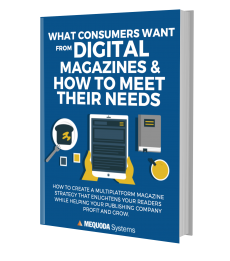Ecommerce content strategy is a digital magazine platform that a good number of publishers are starting to put into practice; plus, time-based advertising is taking off
One of the most significant advantages of a multiplatform strategy is that new digital magazine platform options pop up frequently: They make for a renewable resource that will likely never run out. If you’re willing to put in the work and climb the learning curve as quickly as possible, you can integrate new Internet revenue models at your own pace!
The latest digital magazine platform to gain momentum in the publishing industry is ecommerce, alternately known to some Mequoda Members as the Retail Website Model. When combined with ecommerce content strategy, digital magazines can generate their own opportunities rather than always relying on ads and subscriptions, which can fluctuate.
Always ahead of the latest trends, Digiday recently took a look at two digital publishers diving into ecommerce, but they’ve also got an article on media companies using more traditional means. Let’s see what they have for us this week!
Legacy.com’s Ecommerce Content Strategy: Maybe on the Morbid Side, but Effective!
During the past five years, Legacy.com’s ecommerce revenue has grown about 40% per year, Digiday reports.
“E-commerce is looking increasingly attractive as a monetization strategy for publishers embattled by limited online advertising budgets, demands of 100 percent ad viewability and now ad blocking. But commerce is tricky. Sticking buy buttons near journalistic content can undermine a publisher’s perceived editorial independence. And unless publishers make a full commitment to fulfilling all parts of the transaction, which few are equipped to do, the typical revenue share from e-commerce is small,” Lucia Moses writes.
![DMMS]() Digital magazine subscribers confessed to us everything they want in a digital magazine. Find out what they said in our FREE downloadable Mequoda Digital Magazine Market Study.
Digital magazine subscribers confessed to us everything they want in a digital magazine. Find out what they said in our FREE downloadable Mequoda Digital Magazine Market Study.
“It used to have affiliate relationships with flower vendors, for example, pushing consumers who clicked over to a florist’s site to complete a purchase. Today, Legacy.com still leaves the inventory and delivery to the local florist but has enabled the consumer to complete the entire purchase on Legacy.com, where everything from the flower selections to the checkout process is tailored to the memorial giver. Not having to deal with order fulfillment frees Legacy.com to focus on testing things like how many flower arrangements it should display to maximize purchases.”
How Bleacher Report’s Deep Linking Strategy Is Paying Off
Bleacher Report is deep linking (which allows for more specific referrals to other apps) relevant ecommerce opportunities within its mobile content, and seeing some success, Digiday reports. They’ve partnered with ticketing app Gametime, for instance, enabling consumers to seamlessly navigate between apps – aiding in convenience and solidifying affinity.
Time Is Money: FT’s Time-Based Ad + Sponsored Content Approach
But more traditional publishers shouldn’t fear: There’s still a path to victory when it comes to digital advertising revenue.
The Financial Times is focusing on time-based ad campaigns, Digiday reports, and has signed up more than a dozen brands already. The efforts – which depend on how much time a consumer actually spends on an ad – have generated more than $2.2 million in revenue.
Meanwhile, the Financial Times has dedicated staff to FT Squared, for a “paid posts” option for advertisers, Digiday reports, planning to work with around 10 brands at a time. Of interest to digital publishers: The Financial Times’ internal research told them that 74% of readers appreciated sponsored content if properly labeled, with 58% saying sponsored content is more valuable than traditional advertising.
Niche Publishing Case Study: Everyday Carry
And, finally, a highly recommended piece to check out for niche publishers, which comprise the core of Mequoda Members: A cool article on Everyday Carry, a site that’s literally about what people can carry in their pocket and is getting a million uniques monthly with hundreds of thousands of fans and followers across social media, according to Digiday.
Looking for the best ways to integrate any digital magazine platform that comes your way? Download our free Multiplatform Publishing Strategy Handbook today!
To read more digital magazine platform news, visit Digiday.
The post Meet the the Moment’s Hottest New Digital Magazine Platform appeared first on Mequoda Daily.
 Digital magazine subscribers confessed to us everything they want in a digital magazine. Find out what they said in our FREE downloadable
Digital magazine subscribers confessed to us everything they want in a digital magazine. Find out what they said in our FREE downloadable